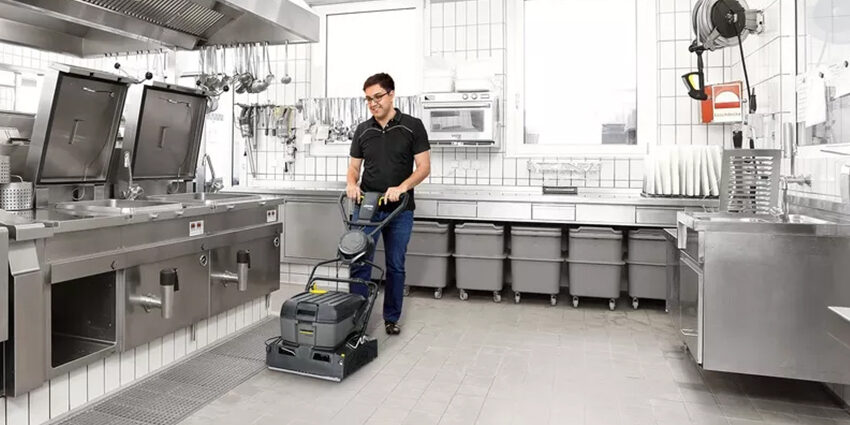Wherever food is cooked, there will be stubborn stains. Grease and food residues must be systematically removed in accordance with the HACCP guidelines, in order to eliminate the breeding grounds for viruses and bacteria. With the right equipment, commercial kitchens can be thoroughly and efficiently cleaned and disinfected.
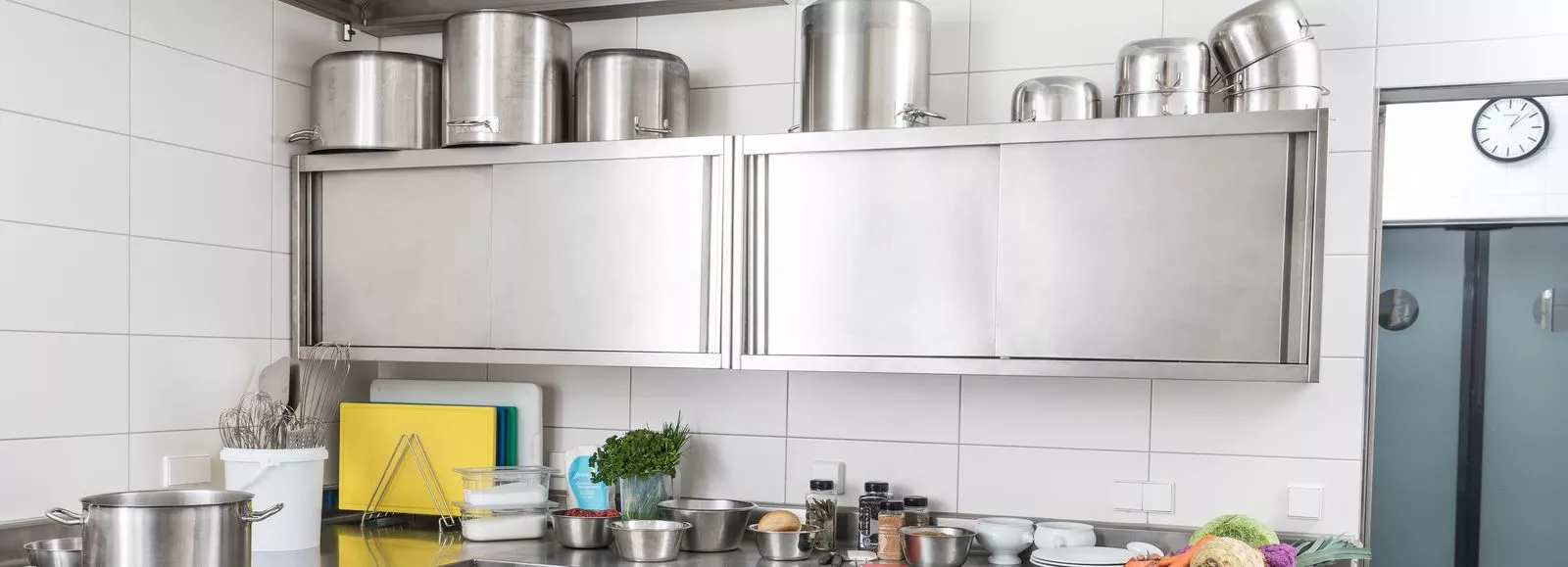
Cleaning and disinfection in accordance with HACCP*
In order to produce hygienically safe food, the kitchen and associated rooms (storage rooms, refrigeration facilities) and the available machines must be kept clean through careful cleaning and disinfection, where appropriate. As the various areas and machines have different cleaning intervals, a cleaning schedule must be created and displayed in a prominent position in each area that requires cleaning. This schedule must clearly specify:
- what must be cleaned (machines, surfaces, floors),
- when to clean (after use, daily, weekly),
- what to clean with (cleaning agent and dosage),
- Who must clean (responsible worker).
Completed tasks must be accurately logged and clearly documented by signature to allow monitoring. It must be noted that cleaning and disinfection are two separate procedures. Cleaning aims to remove dirt and contamination, i.e. any undesirable substances including product residue, microorganisms and cleaning agent/disinfectant residue. Disinfection comprises chemical and physical processes to eliminate microorganisms to a level that is neither hazardous to health, nor damaging to the quality of food.
*HACCP=Hazard Analysis Critical Control Point, a quality tool geared to preventive measures, designed to ensure safety in the production and handling of food and to avoid risks that could lead to illness or injury to consumers.
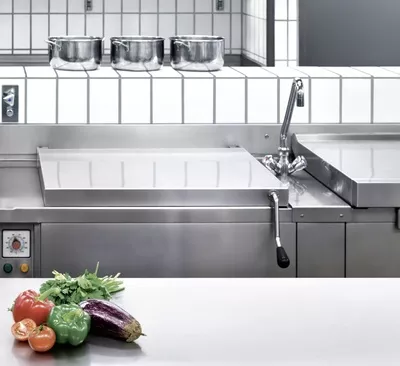
Efficient cleaning in all corners

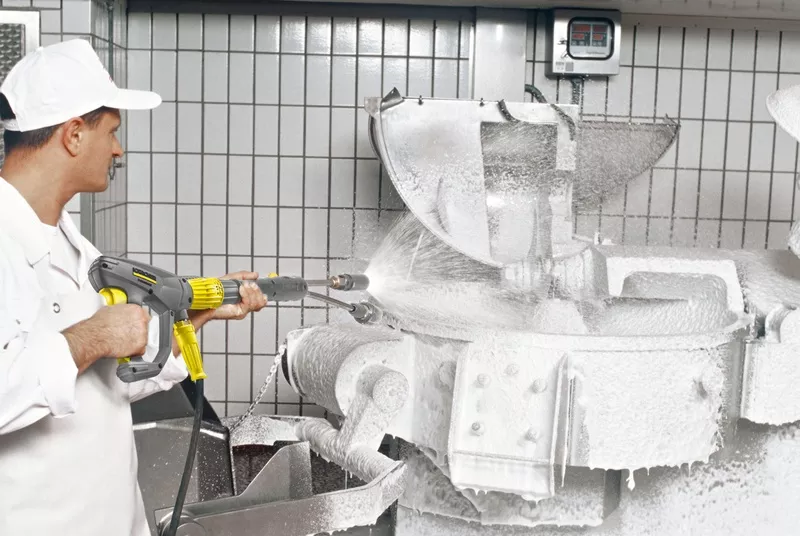 |
Bright tiles and stainless steel characterise the appearance of commercial kitchens. To clean the tiles at the end of a working day, high-pressure cleaners can be used in combination with foam nozzles or cup foam lances. With the aid of the appropriate foam cleaning agents (alkaline/neutral/acidic) and air, which is added at the nozzle, the tools generate foam with the high-pressure jet. The foam is applied from a distance of about one to two meters, working from bottom to top, to make use of the large ejection width. The great thing about this system is that firstly, you can see where the cleaning agent has been applied and secondly, the foam stays in place for longer than a normal cleaning agent, so the time it has to take effect is increased. However, it is important to use only as much foam as comes into direct contact with the surface you wish to clean. This allows you to work efficiently and avoids the problem of excess foam sliding down the surface due to its own weight, which would cancel out the benefit of the increased time the foam has to take effect. The cleaning process is subsequently carried out from top to bottom.
Alternating between acidic and alkaline foam cleaning products is important in order to reliably eliminate the breeding grounds of microorganisms. The only thing to note when using acidic cleaning agents is that the tile joints must first be rinsed with water. This prevents the acid from soaking in and attacking the grouting. |
| Cleaning tilting frying pans requires high-pressure cleaners which allow the user to control the water pressure and quantity via the high-pressure gun. This makes it possible to always work with the appropriate combination, without the dirt splashing back onto the user. Furthermore, as with all electrical fittings, the work must be carried out carefully, with reduced pressure, to protect sensitive electrical equipment from damage. Tools that have proven successful in this respect are very short lances (250 mm) or short spray units, such as a power nozzle fitted directly on the high-pressure gun.
You can also make machines and kitchen utensils reach the required hygiene levels using steam cleaners. The steam exits the nozzle in very fine droplets at a temperature of 100 °C and a pressure of 3 to 4 bar, with an acceleration of approximately 170 km/h. This means that the steam gets into every crevice and rubber fold that a brush or cloth would struggle to reach. This allows thorough and hygienic cleaning of the edges of dishwasher front panels, the on and off switches on cookers and grooved surfaces. Freezers can be defrosted in considerably less time by introducing steam between the ice and the inside wall. For heavy soiling, industrial steam cleaners also provide the option of using chemicals to pretreat the area before vacuuming the dirty residue back up using the reverse suction function. Furthermore, steam cleaners are equipped with self-rinsing programmes for the suction hose and suction tube, to remove dirt residue. |
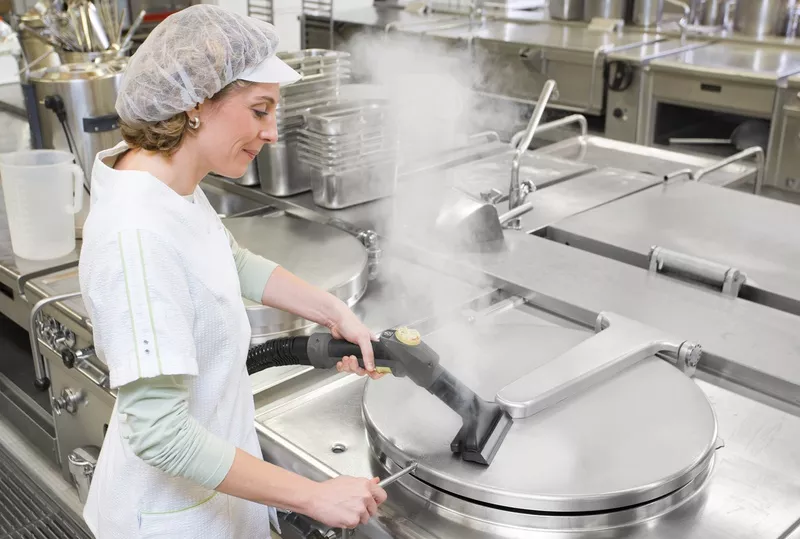 |
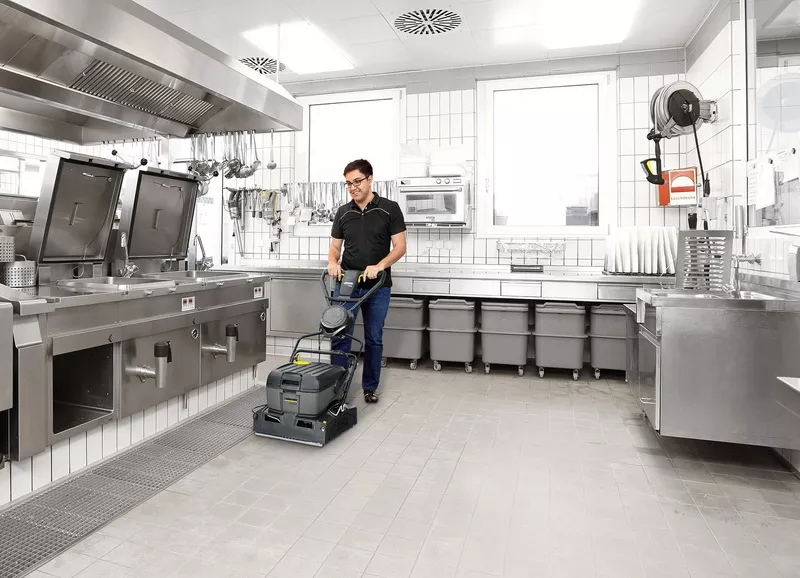 |
The floor of a commercial kitchen is a particular challenge. The background: A very high level of surefootedness is a requirement, in order to prevent work accidents. If a normal floor offers an anti-slip value of R9, a commercial kitchen must have a value of R11 to R13. The structured tiles also have displacement nubs so that water does not create a risk of slipping. Grease and food residue deposited throughout the working day gets caught between these nubs.
Surface cleaners with a rotating nozzle bar, to which power nozzles are attached in a slightly offset position, apply water to the floor at high pressure and very effectively remove the dirt. The bristle rink prevents the water from spraying onto walls and fittings. Depending on the floor structure, the dirty water either runs towards the drain or is pushed towards the drainage channel using a rubber scraper. Alongside the surface cleaner, scrubbers or scrubber driers in the single-disc or roller version, are suitable for floor cleaning. On rough floors, single-disc machines require a high degree of effort as the disc drifts to the right and the user has to continually steer against this. However, roller machines work with counter-rotating rollers; they therefore have neutral movement and are significantly easier to guide. This prevents damage to door frames or edges of built-in cupboards as it is easier to avoid bumping into objects. Furthermore, their small contact face means that they have high contact pressure and the roller shape of the brush enables excellent deep cleaning, allowing structures and joints to be effortlessly cleaned to the desired level. The rollers clean themselves thanks to their high rotational speed, so the dirt doesn’t stick. Compact machines also have a suction function, which reabsorbs the dirty water. The floor dries and can be walked on again immediately. |

